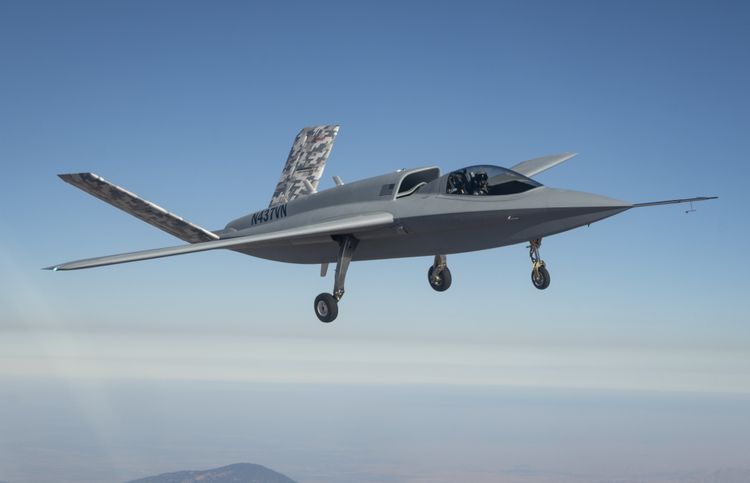The addition of a pilot on Northrop Grumman’s Model 437 “Vanguard” Autonomous Collaborative Aircraft is to speed demonstrations and test flying, because it can overfly populated areas without special permits from the Federal Aviation Administration and is not restricted to test ranges cleared for uncrewed aircraft, the company said.
The Model 437 flew for the first time Aug. 29, flown by company test pilot Brian Maisler out of the Mojave Air & Space Port, Calif. The aircraft is derived from Northrop’s Model 401, which is an uninhabited craft the company said it is using to explore autonomous collaborative projects.
On Sept. 5, Northrop released a video of the Model 437’s first flight, in which it emphasized the digital techniques used to rapidly fabricate and fly the jet. The video also emphasizes that the Model 437’s wings are removable, which is consonant with senior Air Force leader statements that much of its planned Collaborative Combat Aircraft inventory could remain boxed up, and possibly pre-positioned, until needed.
Colin Miller, Northrop’s senior vice president for engineering, said in an email that having a pilot onboard “provides many advantages to demonstrating capabilities without the need to gain special permitting to fly an autonomous aircraft in national airspace.”
The Air Force has been critical in recent years of the FAA’s slowness in opening up more airspace to large uninhabited aircraft, as this has constrained the pace at which new classes of drones can be tested. A pilot onboard can monitor the aircraft when it is in autonomous mode and take the controls if it behaves in an unexpected or dangerous way.
A “future iteration” could be all-autonomous, “while demonstrating other tactical applications our customers desire for autonomous collaborative programs,” Miller said.
Miller declined to say if the Model 437 is aimed specifically at a particular program like the Air Force’s CCA program, in which Northrop is competing for a slot on Increment 2.
“It is a technology demonstrator operated by [Northrop subsidiary] Scaled Composites for a number of applications, including autonomous collaborative aircraft,” he said. “It is not intended for a specific effort, as we have a broad range” of potential applications for the aircraft “for a variety of customers.”
There is no set flight test plan for the Model 437, company officials said. On their websites, Northrop and Scaled said the Vanguard could carry two AIM-120 Advanced Medium Range Air-to-Air Missiles, but Greg Morris, president of Scaled Composites, declined to comment on whether weapons release tests are expected.
“As a technology demonstrator for autonomous and tactical aircraft of this size, Scaled Composites could conduct a number of tests based on customer requirements,” Morris said, but he added that the company “does not provide this information publicly.”
The Model 437 design was unveiled three years ago, and at the time Northrop touted it as a potential competitor for what was then called the Air Force’s “loyal wingman” project. The fact that the company mentioned that it can carry two AMRAAMs dovetails with Air Force senior leader assertions in the last few months that early increments of the CCA will be focused on air-to-air applications. Northrop said the Model 437 can carry up to a 2,000-pound payload.
The ”other customers” Northrop may be referring to for the Model 437 include the U.K., which has a requirement for a CCA-like capability to escort its F-35s, and the Navy, which is pursuing a CCA effort of its own. Northrop designed and tested the X-47 aircraft to demonstrate that a large-size drone could safely and consistently take off from and land on aircraft carriers without human intervention.
Narration in the video says the Model 437 is ‘part of the broader ‘loyal wingman’ concept, which is aimed at creating affordable, multimission and reusable drones that can take on high risk missions to reduce danger to human pilots.”
